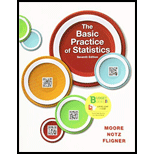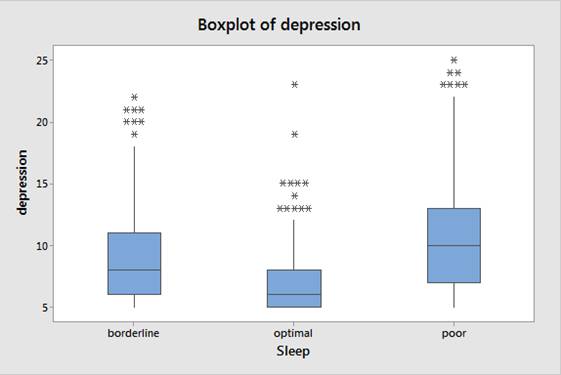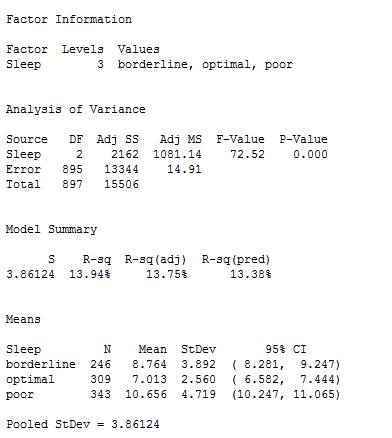
a.
To compare: The depression scores for the three qualities of sleep through a graph using the four-step process in data analysis and ANOVA.
a.
Answer to Problem 27.33E
The comparison of the depression scores for the three qualities of sleep is shown using MINITAB.
Output using the MINITAB software is given below:

At least one of the sleep qualities has different population
Explanation of Solution
Given info:
The dataset shows the quality of sleep and depression scores and here dataset of first seven individuals from a sample of 898 students.
| Quality of sleep: | poor | poor | border | poor | poor | optimal | border |
| Depression score: | 5 | 8 | 5 | 11 | 7 | 7 | 10 |
Justification:
The four-step process in data analysis is as follows,
Plan:
Check the condition and formulate a statistical question that can be answered with data, by any survey or poll. This is the most important step in the process. Here, the survey included questions on the sleep quality, moods, academic performance, physical health, and psychoactive drug use.
Collect:
Implement the plan to collect data through observations, interviews, questionnaires, databases, samplings, experimentation, or surveys. Here, the survey completed on a random sample of 898 students between the ages of 20 and 24 at a university. On the Pittsburgh Sleep Quality Index, students scoring less than or equal to 5 on index are classified as optimal sleepers, students scoring a 6 or 7 are classified as borderline, and those scoring over 7 are classified as poor sleepers.
Process:
Organize and summarize the collected data by graphical or numerical methods. Graph the numerical data using histograms, dot plots or box plots, and analyze the result.
Boxplot:
Step by step procedure to obtain boxplot using the MINITAB software:
- Choose Graph > Boxplot.
- Under One Y, choose With Groups, and then click OK.
- In Graph variables, select the column of depression.
- In Categorical variables for grouping, select the column of Sleep.
- Click OK.
Output using the MINITAB software is given below:

ANOVA:
Step by step procedure to obtain ANOVA using the MINITAB software:
- Choose Stat > ANOVA > One-Way.
- In Response, select the column of depression.
- In Factor, select the column of Sleep.
- Click OK.
Output using the MINITAB software is given below:

From the output, the standard deviation for borderline
The standard deviation must satisfy the rule of thumb.
The value 1.84 is less than 2. So, the condition is satisfied.
Thus, the ANOVA is used to compare the mean lengths for the three populations.
The boxplot shows that all the groups are having the outliers and provide the strong skewness. But the sample is larger up to 898. Therefore, it follows a
The standard deviation satisfy the rule of thumb and the resultant value is less than 2, so, ANOVA is used to compare the mean lengths for the three populations in the quality of sleep.
The four-step process in ANOVA is as follows,
The null and alternative hypothesis:
The Null Hypothesis:
The hypothesis states that there are no differences among the mean lengths.
The Alternative Hypothesis:
The hypothesis states that at least one of the sleep qualities has different mean value in depression and the hypothesis is many-sided.
Decision Rule:
If
If
Conclusion:
The level of significance is,
Here, the P-value is less than the level of significance.
That is,
Hence, there is not sufficient evidence to conclude that differences among the mean lengths are not exist at
Thus, there is a significant difference in the mean of sleep qualities in depression. So, at least one of the sleep qualities has different population mean in depression at 5% level.
b.
To explain: The reason to trust the ANOVA F test to give valid results for the given data.
b.
Explanation of Solution
Justification:
The ANOVA F statistic for I normal population is given as
Where the mean square for groups is,
And the mean square error is,
When
The Analysis of Variance (ANOVA) is a statistical method to test differences between two or more means. The inferences about means are made by analyzing variance.
The test of null hypothesis against alternate hypothesis is called the analysis of variance F test. The test helps in finding whether the null hypothesis is rejected or the alternative hypothesis is accepted. The F-statics and P-values are computed for the result.
In the data all three conditions, that is, poor quality of sleep, optimal quality of sleep and border quality of sleep, are satisfied. The
c.
To explain: The reason of the study is being observational.
To explain: The reason for association not proving causation.
To explain: The poor-quality sleep leading to higher levels of depression.
To explain: The higher depression scores affecting quality of sleep.
c.
Explanation of Solution
Justification:
Observational Study:
An observational study measures the values of a variable without influencing the values of response variables and explanatory variables. Thus, in observational study researchers can observe the behaviors of the individuals without influencing the outcome of that study.
In the observational study, the sleep causation may vary so association does not prove causation. Through causation the students cannot be assigned randomly. The poor-quality sleep may affect the moods, academic performance, physical health, intake of psychoactive drug and thus lead to higher level of depressions. In the Pittsburg Sleep Quality Index (PSQI), students scoring less than or equal to 5 on the index are classified as optimal sleepers, those scoring 6 or 7 are classified as borderline, and those scoring over 7 are classified as poor sleepers. Thus, the poor-quality of sleep leads higher level of depression. In the Profile of Moods State (POMS), the higher scores of index show greater levels of depression.
Want to see more full solutions like this?
Chapter 27 Solutions
Loose-leaf Version for The Basic Practice of Statistics 7e & LaunchPad (Twelve Month Access)
- Suppose the Internal Revenue Service reported that the mean tax refund for the year 2022 was $3401. Assume the standard deviation is $82.5 and that the amounts refunded follow a normal probability distribution. Solve the following three parts? (For the answer to question 14, 15, and 16, start with making a bell curve. Identify on the bell curve where is mean, X, and area(s) to be determined. 1.What percent of the refunds are more than $3,500? 2. What percent of the refunds are more than $3500 but less than $3579? 3. What percent of the refunds are more than $3325 but less than $3579?arrow_forwardA normal distribution has a mean of 50 and a standard deviation of 4. Solve the following three parts? 1. Compute the probability of a value between 44.0 and 55.0. (The question requires finding probability value between 44 and 55. Solve it in 3 steps. In the first step, use the above formula and x = 44, calculate probability value. In the second step repeat the first step with the only difference that x=55. In the third step, subtract the answer of the first part from the answer of the second part.) 2. Compute the probability of a value greater than 55.0. Use the same formula, x=55 and subtract the answer from 1. 3. Compute the probability of a value between 52.0 and 55.0. (The question requires finding probability value between 52 and 55. Solve it in 3 steps. In the first step, use the above formula and x = 52, calculate probability value. In the second step repeat the first step with the only difference that x=55. In the third step, subtract the answer of the first part from the…arrow_forwardIf a uniform distribution is defined over the interval from 6 to 10, then answer the followings: What is the mean of this uniform distribution? Show that the probability of any value between 6 and 10 is equal to 1.0 Find the probability of a value more than 7. Find the probability of a value between 7 and 9. The closing price of Schnur Sporting Goods Inc. common stock is uniformly distributed between $20 and $30 per share. What is the probability that the stock price will be: More than $27? Less than or equal to $24? The April rainfall in Flagstaff, Arizona, follows a uniform distribution between 0.5 and 3.00 inches. What is the mean amount of rainfall for the month? What is the probability of less than an inch of rain for the month? What is the probability of exactly 1.00 inch of rain? What is the probability of more than 1.50 inches of rain for the month? The best way to solve this problem is begin by a step by step creating a chart. Clearly mark the range, identifying the…arrow_forward
- Client 1 Weight before diet (pounds) Weight after diet (pounds) 128 120 2 131 123 3 140 141 4 178 170 5 121 118 6 136 136 7 118 121 8 136 127arrow_forwardClient 1 Weight before diet (pounds) Weight after diet (pounds) 128 120 2 131 123 3 140 141 4 178 170 5 121 118 6 136 136 7 118 121 8 136 127 a) Determine the mean change in patient weight from before to after the diet (after – before). What is the 95% confidence interval of this mean difference?arrow_forwardIn order to find probability, you can use this formula in Microsoft Excel: The best way to understand and solve these problems is by first drawing a bell curve and marking key points such as x, the mean, and the areas of interest. Once marked on the bell curve, figure out what calculations are needed to find the area of interest. =NORM.DIST(x, Mean, Standard Dev., TRUE). When the question mentions “greater than” you may have to subtract your answer from 1. When the question mentions “between (two values)”, you need to do separate calculation for both values and then subtract their results to get the answer. 1. Compute the probability of a value between 44.0 and 55.0. (The question requires finding probability value between 44 and 55. Solve it in 3 steps. In the first step, use the above formula and x = 44, calculate probability value. In the second step repeat the first step with the only difference that x=55. In the third step, subtract the answer of the first part from the…arrow_forward
- If a uniform distribution is defined over the interval from 6 to 10, then answer the followings: What is the mean of this uniform distribution? Show that the probability of any value between 6 and 10 is equal to 1.0 Find the probability of a value more than 7. Find the probability of a value between 7 and 9. The closing price of Schnur Sporting Goods Inc. common stock is uniformly distributed between $20 and $30 per share. What is the probability that the stock price will be: More than $27? Less than or equal to $24? The April rainfall in Flagstaff, Arizona, follows a uniform distribution between 0.5 and 3.00 inches. What is the mean amount of rainfall for the month? What is the probability of less than an inch of rain for the month? What is the probability of exactly 1.00 inch of rain? What is the probability of more than 1.50 inches of rain for the month? The best way to solve this problem is begin by creating a chart. Clearly mark the range, identifying the lower and upper…arrow_forwardProblem 1: The mean hourly pay of an American Airlines flight attendant is normally distributed with a mean of 40 per hour and a standard deviation of 3.00 per hour. What is the probability that the hourly pay of a randomly selected flight attendant is: Between the mean and $45 per hour? More than $45 per hour? Less than $32 per hour? Problem 2: The mean of a normal probability distribution is 400 pounds. The standard deviation is 10 pounds. What is the area between 415 pounds and the mean of 400 pounds? What is the area between the mean and 395 pounds? What is the probability of randomly selecting a value less than 395 pounds? Problem 3: In New York State, the mean salary for high school teachers in 2022 was 81,410 with a standard deviation of 9,500. Only Alaska’s mean salary was higher. Assume New York’s state salaries follow a normal distribution. What percent of New York State high school teachers earn between 70,000 and 75,000? What percent of New York State high school…arrow_forwardPls help asaparrow_forward
- Solve the following LP problem using the Extreme Point Theorem: Subject to: Maximize Z-6+4y 2+y≤8 2x + y ≤10 2,y20 Solve it using the graphical method. Guidelines for preparation for the teacher's questions: Understand the basics of Linear Programming (LP) 1. Know how to formulate an LP model. 2. Be able to identify decision variables, objective functions, and constraints. Be comfortable with graphical solutions 3. Know how to plot feasible regions and find extreme points. 4. Understand how constraints affect the solution space. Understand the Extreme Point Theorem 5. Know why solutions always occur at extreme points. 6. Be able to explain how optimization changes with different constraints. Think about real-world implications 7. Consider how removing or modifying constraints affects the solution. 8. Be prepared to explain why LP problems are used in business, economics, and operations research.arrow_forwardged the variance for group 1) Different groups of male stalk-eyed flies were raised on different diets: a high nutrient corn diet vs. a low nutrient cotton wool diet. Investigators wanted to see if diet quality influenced eye-stalk length. They obtained the following data: d Diet Sample Mean Eye-stalk Length Variance in Eye-stalk d size, n (mm) Length (mm²) Corn (group 1) 21 2.05 0.0558 Cotton (group 2) 24 1.54 0.0812 =205-1.54-05T a) Construct a 95% confidence interval for the difference in mean eye-stalk length between the two diets (e.g., use group 1 - group 2).arrow_forwardAn article in Business Week discussed the large spread between the federal funds rate and the average credit card rate. The table below is a frequency distribution of the credit card rate charged by the top 100 issuers. Credit Card Rates Credit Card Rate Frequency 18% -23% 19 17% -17.9% 16 16% -16.9% 31 15% -15.9% 26 14% -14.9% Copy Data 8 Step 1 of 2: Calculate the average credit card rate charged by the top 100 issuers based on the frequency distribution. Round your answer to two decimal places.arrow_forward
 MATLAB: An Introduction with ApplicationsStatisticsISBN:9781119256830Author:Amos GilatPublisher:John Wiley & Sons Inc
MATLAB: An Introduction with ApplicationsStatisticsISBN:9781119256830Author:Amos GilatPublisher:John Wiley & Sons Inc Probability and Statistics for Engineering and th...StatisticsISBN:9781305251809Author:Jay L. DevorePublisher:Cengage Learning
Probability and Statistics for Engineering and th...StatisticsISBN:9781305251809Author:Jay L. DevorePublisher:Cengage Learning Statistics for The Behavioral Sciences (MindTap C...StatisticsISBN:9781305504912Author:Frederick J Gravetter, Larry B. WallnauPublisher:Cengage Learning
Statistics for The Behavioral Sciences (MindTap C...StatisticsISBN:9781305504912Author:Frederick J Gravetter, Larry B. WallnauPublisher:Cengage Learning Elementary Statistics: Picturing the World (7th E...StatisticsISBN:9780134683416Author:Ron Larson, Betsy FarberPublisher:PEARSON
Elementary Statistics: Picturing the World (7th E...StatisticsISBN:9780134683416Author:Ron Larson, Betsy FarberPublisher:PEARSON The Basic Practice of StatisticsStatisticsISBN:9781319042578Author:David S. Moore, William I. Notz, Michael A. FlignerPublisher:W. H. Freeman
The Basic Practice of StatisticsStatisticsISBN:9781319042578Author:David S. Moore, William I. Notz, Michael A. FlignerPublisher:W. H. Freeman Introduction to the Practice of StatisticsStatisticsISBN:9781319013387Author:David S. Moore, George P. McCabe, Bruce A. CraigPublisher:W. H. Freeman
Introduction to the Practice of StatisticsStatisticsISBN:9781319013387Author:David S. Moore, George P. McCabe, Bruce A. CraigPublisher:W. H. Freeman





